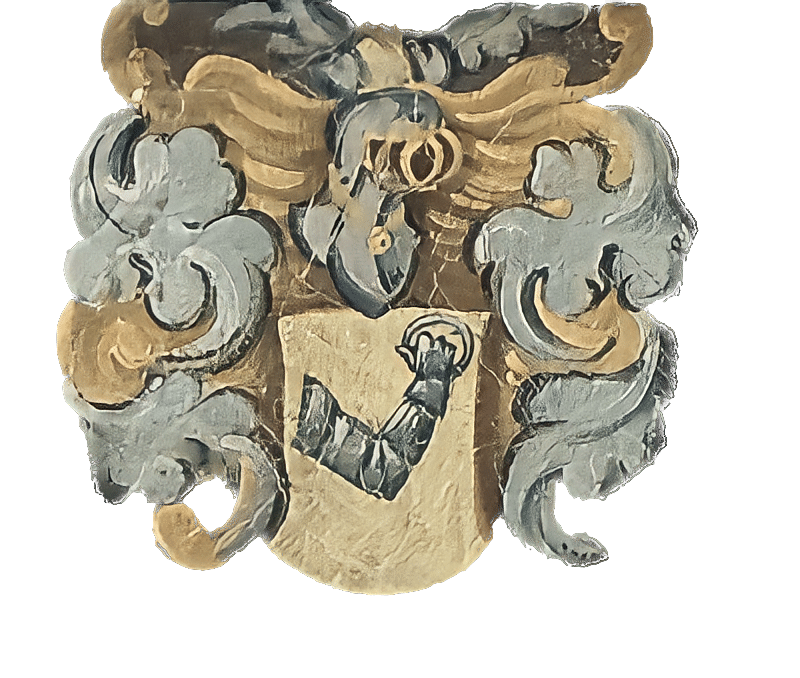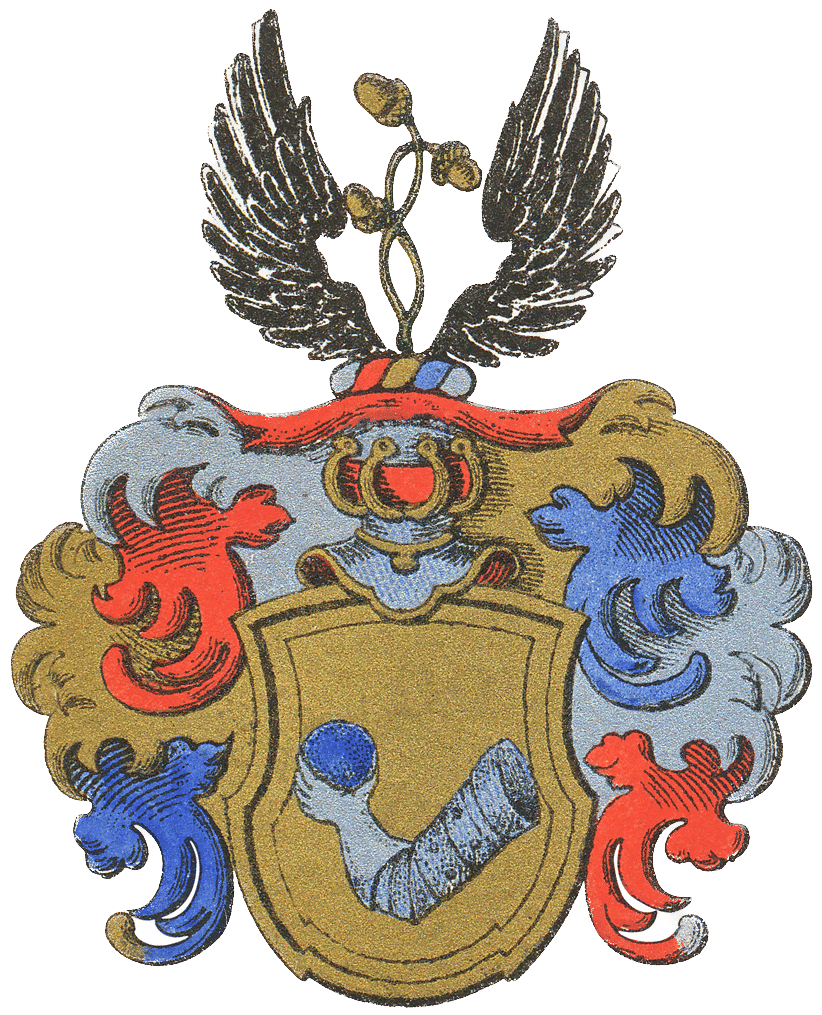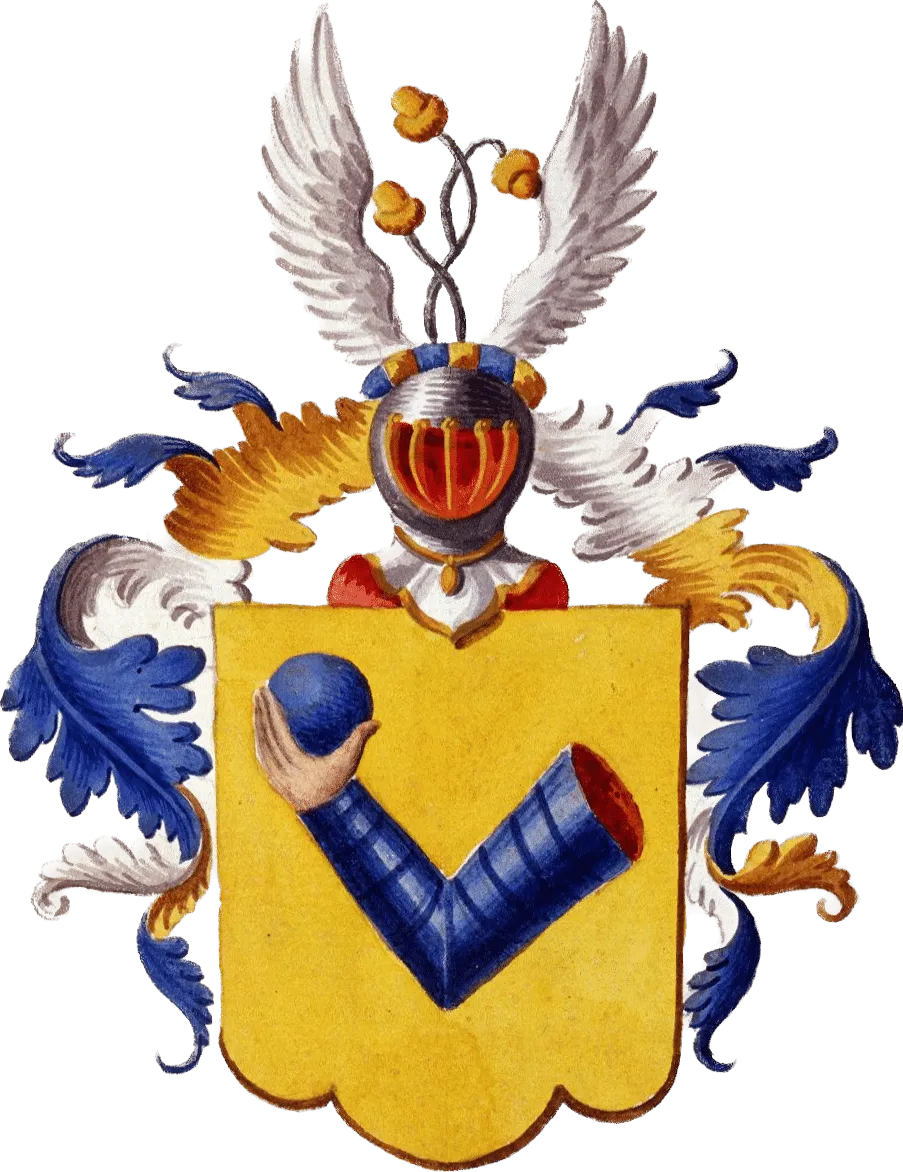The family coat of arms
There have been many different coats of arms as well as slight variations to the family arms over the centuries. For example, a 1623 painting of Jöran Polman features a coat of arms with an armoured arm holding a ring. The coat of arms associated with the Swedish Påhlmans, knighted in 1650, is similar, though the arm is reversed and now holds a cannonball. The Estonian von Pohlmanns seal bears even more similarities to the Påhlman coat of arms, including the overall colour palette. Other renditions of the Pohlmann seal in the 18th century included three eagles (Christian Friedrich Pohlmann, Germany, 1736[[1]]) and acorns.[[2]]
The family history collection contains a total of 350 members of the lineage, which are spelled very differently, such as: Polemann, Pollmann, Poldemann, Polmann, Bolemann and Pohlmann, as well as drawings of many coats of arms and seals.[[3]]
Polman/Pohlmann
Westphalia
It is said that the family originally came from the parish of Hille, in the county of Ravensberg, Westphalia, where there was a noble family named Polman. The coat of arms depicted an armoured arm holding a ring.[[4]] A Herman Pohlmann, his wife and a son, Johan, born 13 June 1619 are buried in the Hille cemetery. Generally, a heraldic coat of arms is defined by a formal description of the arms called a blazon. There is no known blazon for the Westphalian family Polman; the only known image of the arms that survives is from a painting of Jöran Polman painted in 1623.
Shield or escutcheon

The most important part of the armorial achievement is the shield, which bears the arms. In the Polman arms, the shield is gold or yellow with a curved arm, clad in armor, holding a ring or annulet with a silver gauntlet turned to the left.[[5]] The annulet is a plain ring that symoblizes continuity, wholeness, and fidelity. It also indicated royal favor and protection and may have been used to signify that the bearer had the superior qualities of a knight. In some circles an annulet represented riches.
Helmet and crest
In Swedish heraldry, an open helmet is used exclusively for the nobility. There can be more than one helmet for titled nobility — barons have two and counts have three open helmets above their shield. This tradition dates back to the late 16th century because an incorrect number of helmets means that one is claiming to have received a royal fief.[[6]] Here, we can see an open helmet with a necklace, suggesting that Jöran Polman was from a noble family in 1623. Above the helmet is the helmet ornament or crest, which can be a motif that is the same as the shield image or a unique symbol. The painting cuts off, but we may see the start of wings as part of the helmet decoration.
Påhlman
Sweden, no. 501
In Sweden, the sons of Jöran Polman, Johan and Gustaf Polman, were ennobled with the name Påhlman in 1650. Later, their sister, Anna Christina, was entitled to inherit the nobility as well. The coat of arms (Swedish: vapensköld) associated with this line of the family depicted a shield in yellow with a curved arm in armor.

Blazon or description
Shield: golden, floating in it a severed link arm, red at the cut, blue armored, curved, in the bare hand turned to the right with a silver gauntlet holding a blue ball.
Helmet (blue-gold – walled): between open black wings a green entwined stalk with 3 golden acorns.
Covers: blue-gold-silver.J. Siebmacher’s Grosses Und Allgemeines Wappenbuch[[7]]
Shield or escutcheon
The arm, with a silver gauntlet, held a blue ball and was turned towards the right.[[8]] The arm is holding a bullet or ball but the Swedish description is two words for the same thing – a cannonball.[[9]] The armoured arm holding a cannonball signified a person with qualities of leadership, a person fit for high deeds, and one who has dared the terror of such a weapon in battle. The helmet cover is distributed in white, blue, and yellow.
Helmet and crest
Above the helmet stands a growing oak twig with three large acorns rising upward, nestled between a pair of black wings – perhaps symbolic of antiquity, strength, and swiftness in its bearer.
von Pohlmann
Estonia, no. 112
Another branch of the family was registered at the Knights’ House in Reval, Estonia under No. 112. This line of the family – von Pohlmann – was probably started by Claus von Pohlmann (born Polman or Pohlmann), a son of the family progenitor, Jürgen Polman. The design of the coat of arms is largely the same but with a bare hand and no glove. This original shield letter (known as “sköldebrevet” in Swedish) had colours of white, blue, and yellow which are accurately represented in this depiction of the coat of arms. However, the wings are described in the blazon as black, rather than the white colour shown here.

It should be noted that the shape of the shield is never specified, allowing each artist the freedom to select the framing or shape that most suits the arms.[[10]]
[[1]]: He presumably changed his arms. (see: Horst Karl Adolf von der. 1894. Die Rittersitze Der Grafschaft Ravensberg Und Des Fürstentums Minden [The knight seats of the county of Ravensberg and the principality of Minden]. Berlin: Stargardt, 74.)
[[2]]: Max Müller, Beitrag zur Baltischen Wappenkunde (E. Plates, 1931)
[[3]]: Jahrbuch für Genealogie, Heraldik und Sphragistik, 1897
[[4]]: “Påhlman nr 501” Adelsvapen-Wiki, accessed March 17, 2022, https://www.adelsvapen.com/genealogi/Påhlman_nr_501
[[5]]: The arms is always described from the perspective of the arms bearer. This means that the right for the wearer becomes the left for the spectator.
[[6]]: Wasling, Jesper. Heraldik För Nybörjare. Borås: Svenska heraldiska föreningen, 2012.
[[7]]: Gritzner Maximilian Otto Titan von Hefner and Johann Siebmacher. 1896. J. Siebmacher’s Grosses Und Allgemeines Wappenbuch Bd. 3 Abth. 11 Der Adel Der Russischen Ostseeprovinzen Teil 1 Die Ritterschaft Neue vollst. geordnete und reich verm. Aufl ed. Nürnberg: Bauer & Raspe.
[[8]]: Stackelberg, Otto Magnus von. Genealogisches Handbuch der estländischen Ritterschaft. Görlitz, 1931.
[[9]]: Rosell Johan, Bäckmark Magnus, Claes G Ellehag, Kaj Janzon and Gabriel Hildebrand. 2019. Riddarhusets Vapensköldar Band 1. Stockholm: Riddarhusdirektionen.
[[10]]: Wasling, Jesper. Heraldik För Nybörjare. Borås: Svenska heraldiska föreningen, 2012.
